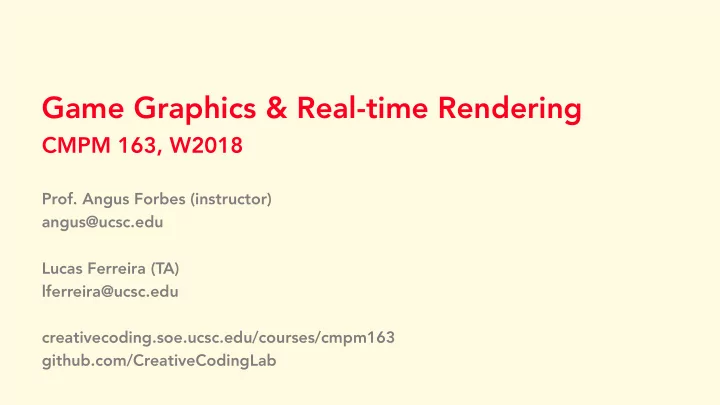

Game Graphics & Real-time Rendering CMPM 163, W2018 Prof. Angus Forbes (instructor) angus@ucsc.edu Lucas Ferreira (TA) lferreira@ucsc.edu creativecoding.soe.ucsc.edu/courses/cmpm163 github.com/CreativeCodingLab
About Me - New assistant professor in UCSC’s Computational Media department - Direct the Creative Coding lab - Teach courses on data visualization and computer graphics - Used to run Synaesthetic Software, a music education software company
Research Interests Main areas: - Visualization & Visual Analytics - Computer Graphics - VR / AR - New Media Arts Also: - Applied ML, Digital humanities, HCI, Network science, Data sonification, etc.
Recent Research Projects - Focus on novel ways to represent and analyze dynamic, complex networks - Collaborate with scientists to design visualization tools to make it easier to reason about their data - Enormous opportunity for creative, computational researchers and artists to use graphics techniques to help make sense of “big data”
Dynamic Influence Networks
NeuroCave
Annotating Complex Natural Language Phenomena
Creative Research - New forms of representation and interaction - AR, VR, Deep Learning - Design thinking / Graphic design / Interactive design
Inviso
Deep Illumination
Computational Art - Using computational media to create interactive artworks - Visualizing archives, cultural datasets - Algorithmic, generative graphics
Fluid Automata
Macondo
Video Granular Synthesis
Riverwalk
What is this class about? “This course introduces real-time hardware-accelerated graphics programming suitable for game development, visual effects, and interactive projects. Emphasis will be placed on shader programming and developing custom effects using game engines and multimedia software. We will read from recent journal articles and online publications, and also survey the use of visual effects in films, interactive media, VR experiences, and video games. In addition to two comprehensive exams and the completion of shorter assignments throughout the semester, students will be responsible for a project that involves the creation, demonstration, and documentation of a real-time graphics technique.”
What is this class about? Programming Real-time Graphics - We will gain experience writing GLSL programs, or shaders , to create visual effects for video games and interactive projects - We will use Three.js to start with, but shaders are used throughout graphics programming, including in the Unity and Unreal game engines Exploring Visual Effects - We will use our knowledge of these shader programs, we’re going to explore a range of visual effects that are used in games, interactive media arts projects, VR experiences, etc.
What is this class about? Visual effects techniques - Lights & shadows - Reflection and refraction for mirrored and transparent materials - Noise functions and particle systems for simulating naturalistic behaviors of explosions, fluids, clouds - Procedurally generated textures, etc. - Lasers, lens flares, god rays When to use visual effects? - We will learn to analyze visual effects to understand how they were created, and also to get a sense of when and why they are effective - You’ll also be asked to join a team to investigate and implement your own visual effects technique
How does this differ from CMPS 160? Less emphasis on mathematic fundamentals - You can’t get away from needing some math, but I won’t be testing you on your linear algebra or matrix operations — Except as they are used to produce visual effects. Survey of visual effects - This course is meant to both be a survey of visual effects used in interactive projects, and also a bootcamp to learn shader programming. No reason why you can’t take both courses - You can definitely take both courses to learn more about graphics, and if you are interested in becoming a game developer, then you encouraged to do so!
What will you learn? By the end of this course: - You should have a good understanding of how graphics are rendered to a display in real-time - You should have insight into some of the popular visual effects that are found in contemporary video games - You should have the ability to implement these visual effects and to customize them or to create your own
How will you learn? Homework Three homework packets will give you an opportunity to practice using shaders to create or customize visual effects. Group project A larger project that will ask you to create your own visual effect or emulate an effect used in a game or media arts project Exams Two exams (midterm & final) will test your knowledge of GLSL programming concepts
Guest speakers We’ll invite folks from the game industry, folks who work on graphics hardware, and media artists to discuss topics in computer graphics.
Class information Class website: https://creativecoding.soe.ucsc.edu/courses/cmpm163 Slack is the main form of class communication: https://ucsc-creativecoding.slack.com/messages/cmpm163 https://ucsc-creativecoding.slack.com/messages/cmpm163-lab
Questions – Write down answers - What was a game you played or video you saw that had interesting visual effects? - What was interesting about it? - Was it a realistic effect, or a creative effect? - How did it effect the mood or narrative? - How do you think it was created?
Questions – Talk to neighbor(s) Introduce yourself: - What’s your name? - Why are you interested in Game Graphics? - Have you done any graphics programming before? - What software packages and programming languages are you most familiar with? - Give them an overview of the questions you wrote down
For Thursday Play around with Three.js: - Make sure you can get the Three.js library downloaded + working on your laptop or a lab computer - Get the code example from this page to work: https://threejs.org/docs/index.html#manual/introduction/Creating- a-scene - Look through the example code at: https://threejs.org/examples/ - Some examples: - https://threejs.org/examples/#webgl_materials_shaders_fresnel - https://threejs.org/examples/#webgl_shader_lava - https://threejs.org/examples/#webgl_shaders_ocean - https://threejs.org/examples/#webgl_shader2
Questions?
Game Graphics & Real-time Rendering CMPM 163, W2018 Prof. Angus Forbes (instructor) angus@ucsc.edu Lucas Ferreira (TA) lferreira@ucsc.edu creativecoding.soe.ucsc.edu/courses/cmpm163 github.com/CreativeCodingLab
Recommend
More recommend